The desert pops
Lots of rain, sunshine, and warm temperatures after a tough winter have started the desert’s flower-fueled engines, pumping poppies out of “nowhere” like magician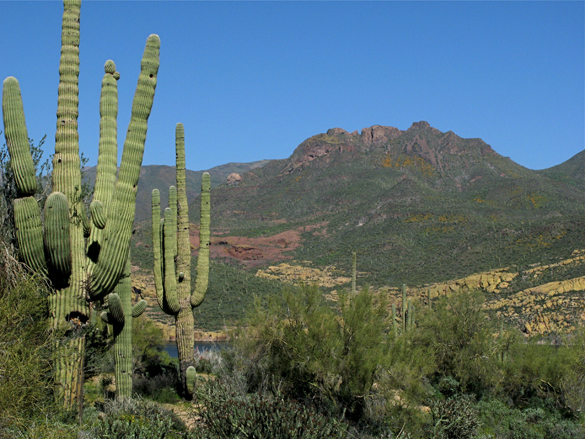 ‘s flowers.
‘s flowers.
<< View across Bartlett Lake to SB Mountain in the Mazatzal Wilderness area. The bright orange wash just below the high peaks is poppy fields. The bright green on the lower right edge of the image is chartreuse lichen on the “Yellow Cliffs”.
E and I entered the flowery fray on Sunday, in search of blooms. The west side of Bartlett Lake was our destination — we realized we’d never been there in all these years — and it was good. To those searching solitude, I should explain that the lake itself is potentially off-putting; not its actual self, or setting, or vistas, which are spectacular, but because on weekends speed boats and jet skis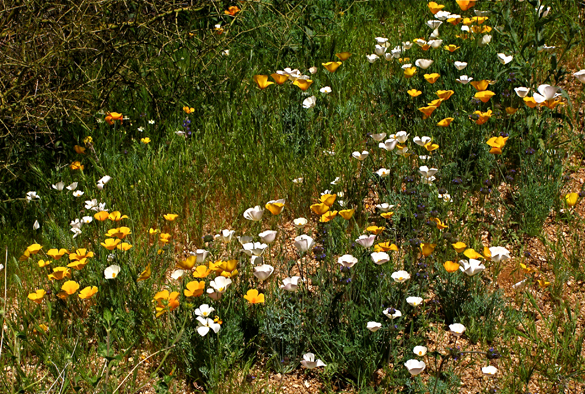 and other motorized etceteræ mix with the sound of the breeze in the saguaro needles, and the blue calm of the water.
and other motorized etceteræ mix with the sound of the breeze in the saguaro needles, and the blue calm of the water.
>> Roadside mix of orange and less common white Mexican Gold Poppy (Eschsholzia californica ssp. mexicana, see last photo below for portrait of a white poppy)
This early in the season this traffic is bearable since it’s nowhere near the height of the boys-with-toys influx and fossil fuel frenzy which will invade after school’s out and with warmer temps. But here you’re on the edge of wilderness, not in it. Fortunately, the shoreside trail we chose to explore was near a non-motorized cove, which meant most of the motorcraft were inaudible on the opposite side of the lake, and the hardy, self-powered paddle-boarders and unexpected numbers of distance swimmers 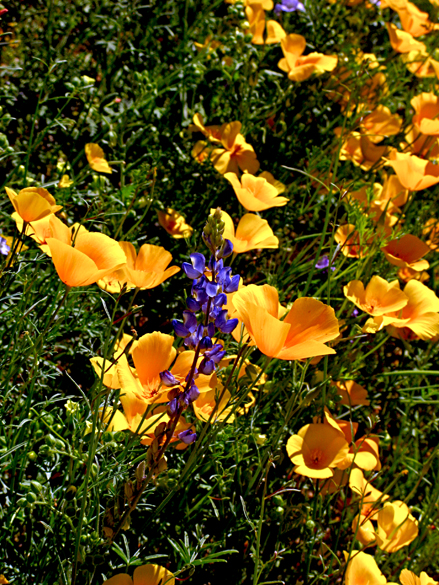 braving the winter-cold riffles were impossible to object to.
braving the winter-cold riffles were impossible to object to.
<< More Mexican gold poppy and Coulter’s Lupine (Lupinus sparsiflorus).
The annual bloom seemed near peak, scattered in the granite gravelly bits among tough perennials like Chuparosa, Brittlebush, Pink Fairy Duster, Buckwheat, and Desert Lavender. The saguaros and other spring-blooming cactus haven’t begun yet here, but the Ocotillo are in leaf, and in a week or two their hot-poker flowers will ignite their branch tips.
New to us was the subtle but spectacular Mentzelia (probably involucrata, Sand Blazing Star), which we missed on the outward bound walk but caught on the back-track — probably because it opened its transluscent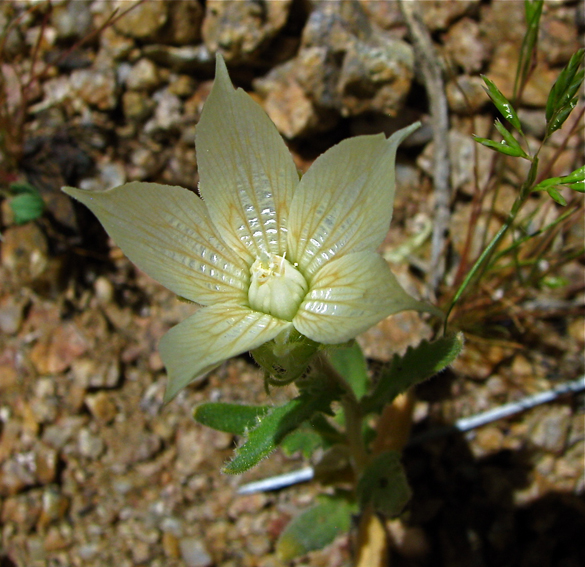 cream-colored flowers mid-morning, after we passed them earlier on. >>
cream-colored flowers mid-morning, after we passed them earlier on. >>
Lizards were the only reptiles we encountered — including the largest Tiger Whiptails I’ve ever seen! — and birds were active with spring pursuits. Most were “the usual suspects”: the locals like Northern Cardinals, Verdin, Rock and Cactus Wren, Common Ravens, an American Kestrel hunting for shoreline grasshoppers from a lake-side snag. There were some newly-returned breeders, like a Bell’s Vireo emitting its chewy song from within the brush, Black-tailed Gnatcatchers, Ash-throated Flycatcher, and a spectacular male Vermilion Flycatcher performing his rising, stalling, and calling nuptial flight, glowing red like a stoplight against the blue sky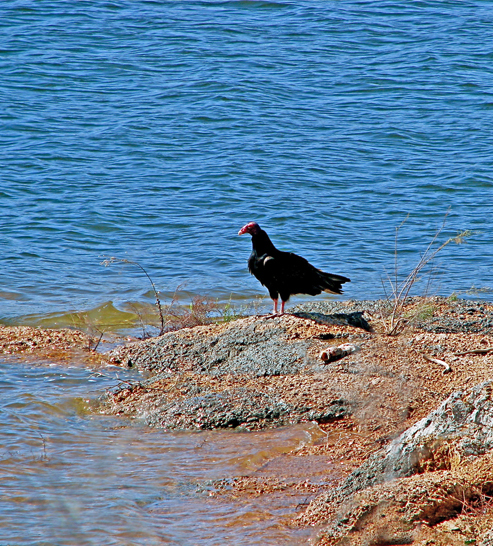 (click here to view an excellent slo-mo video of a male feeding). There was even a Turkey Vulture doing an impression of a shorebird (photo E.Shock)>>
(click here to view an excellent slo-mo video of a male feeding). There was even a Turkey Vulture doing an impression of a shorebird (photo E.Shock)>>
Chia buds were up and only beginning to open, but the curled necks of purplish Scorpion weed (Phacelia ambigua, below) nodded over the trail in places, as well as Woolly Daisies, two species of Camissonia, Whispering Bells, Fiddleneck, Blue dicks, Gilia, Cream cups, and Desert Marigold.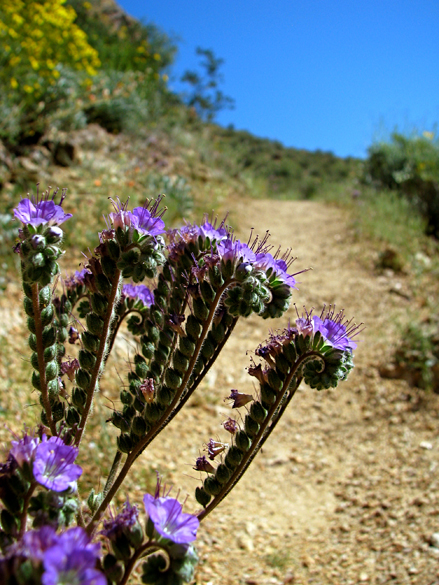
<< Scorpion weed (photo E.Shock)
About three roundtrip miles of hiking and a trip up the road yielded around twenty species of annuals either in bloom or about to bloom (no doubt more for those with more expertise).
For dessert, below is a close-up of a fully open, satiny white poppy, agitated by both bees and the breeze, dusted with its own pollen.
(All photos by A.Shock, unless noted. Be sure to click on each, in some cases to enlarge, but also because clicked-on images in WordPress generally have better resolution than images embedded in the text.)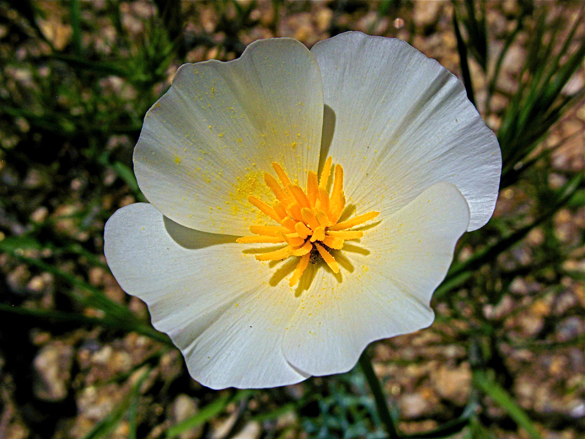

Lovely. Glad it has warmed up out there finally.
Me, too, Roberta — we’re especially grateful because the rest of the country is buried knee-deep in winter, again. But, of course, we usually go from 0 to 60 here in just a few weeks, so we must enjoy it while it’s this beeooteeful.